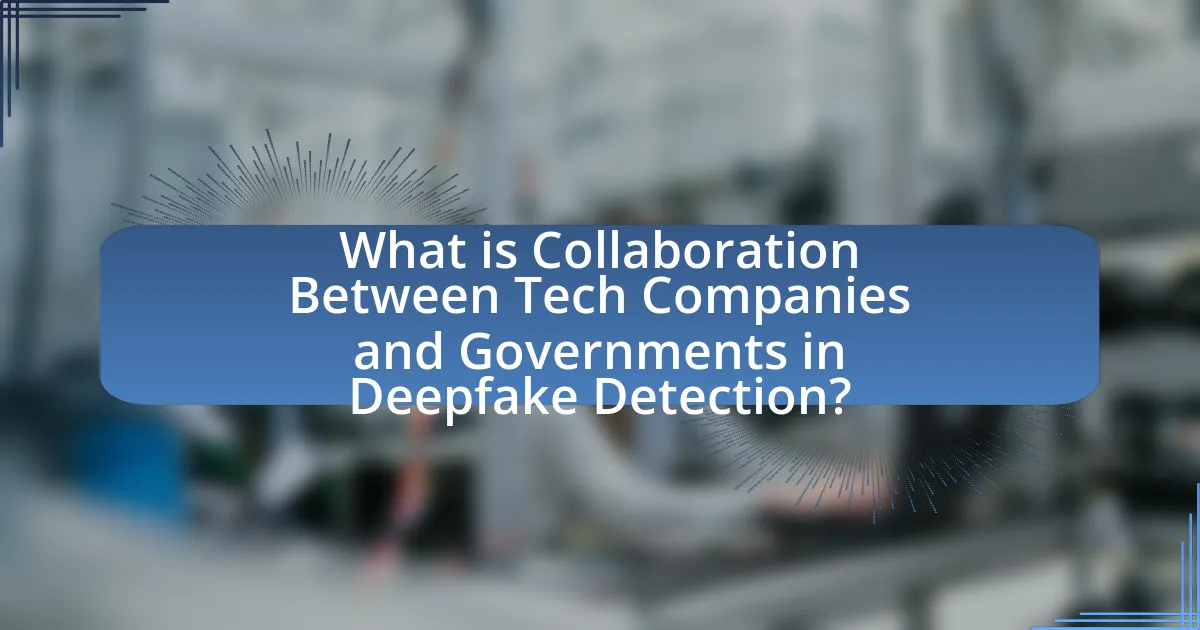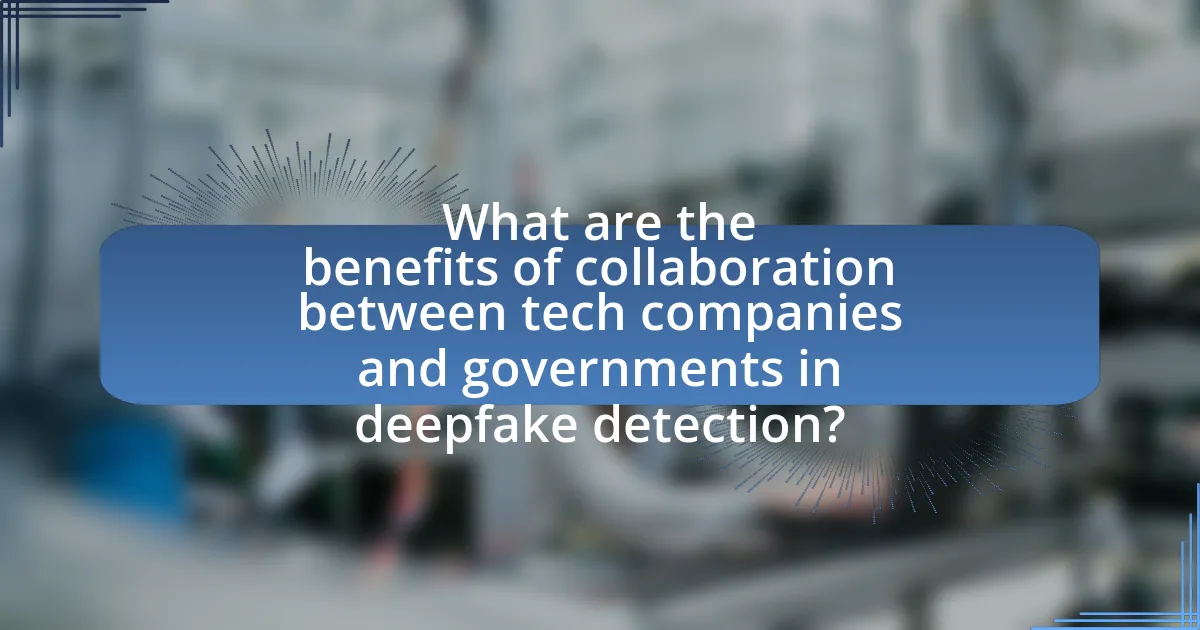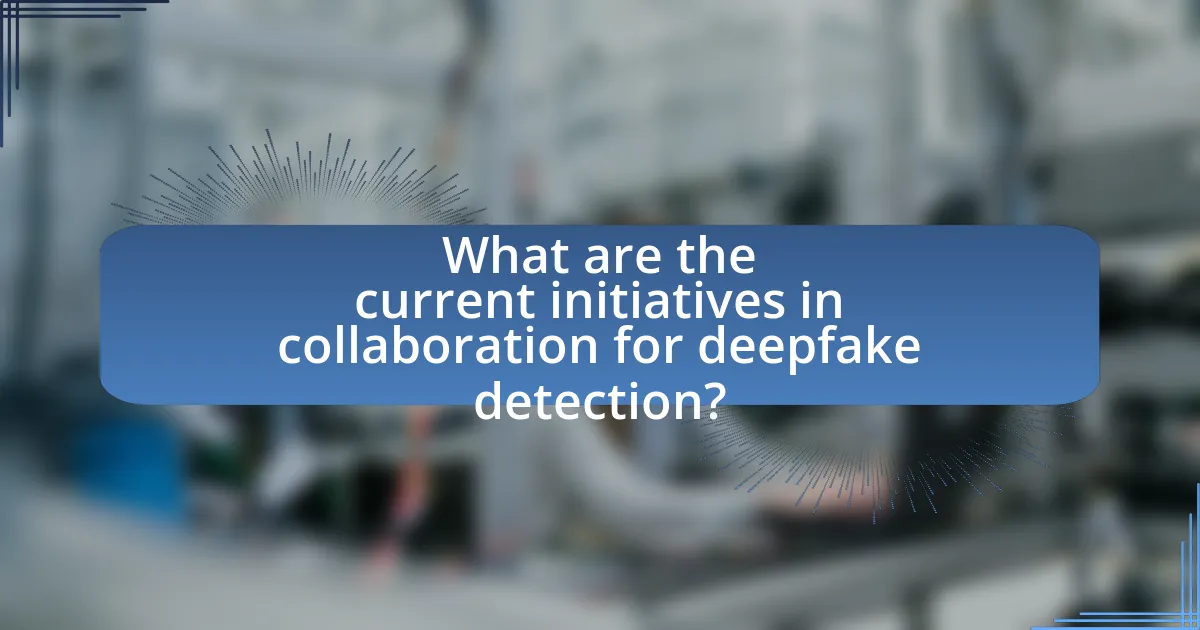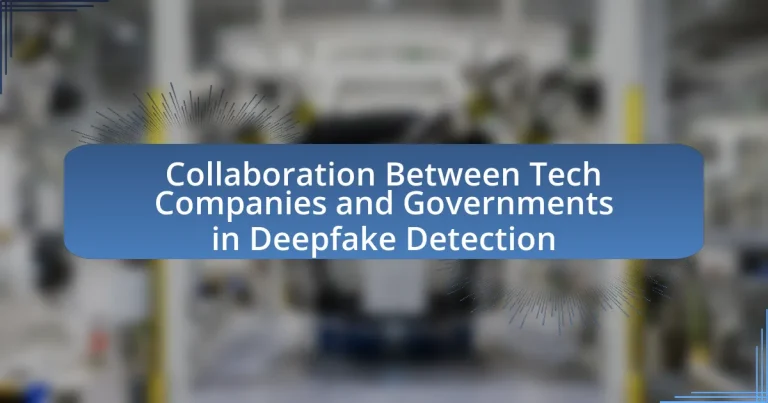Collaboration between tech companies and governments in deepfake detection is essential for developing effective technologies to identify and mitigate the risks associated with deepfake content. This partnership combines the advanced technical capabilities of tech companies with the regulatory frameworks provided by governments, enhancing detection accuracy and fostering public trust. Key challenges include the rapid evolution of deepfake technology and ethical concerns regarding data privacy and accountability. Current initiatives, such as the Deepfake Detection Challenge, exemplify successful collaborations that leverage shared resources and expertise to combat misinformation and improve detection methods. Future trends indicate a growing emphasis on international cooperation and standardized protocols to address the global nature of deepfake threats.

What is Collaboration Between Tech Companies and Governments in Deepfake Detection?
Collaboration between tech companies and governments in deepfake detection involves joint efforts to develop and implement technologies that can identify and mitigate the risks posed by deepfake content. This partnership is crucial as deepfakes can undermine trust in media and facilitate misinformation. For instance, initiatives like the Deepfake Detection Challenge, supported by organizations such as Facebook and the Partnership on AI, aim to advance detection technologies through shared resources and expertise. Additionally, governments are increasingly recognizing the need for regulatory frameworks that can guide the ethical use of AI technologies, while tech companies contribute their technical capabilities to enhance detection methods. This synergy is essential for creating robust solutions to combat the challenges posed by deepfake technology.
Why is collaboration necessary for deepfake detection?
Collaboration is necessary for deepfake detection because it combines the expertise and resources of both tech companies and governments to effectively combat the rapidly evolving threat of deepfakes. Tech companies possess advanced technological capabilities and data analytics, while governments provide regulatory frameworks and public awareness initiatives. This partnership enhances the development of sophisticated detection tools and promotes the sharing of information regarding emerging deepfake techniques. For instance, a study by the University of California, Berkeley, highlights that collaborative efforts can lead to a 30% increase in detection accuracy when diverse datasets are utilized. Thus, collaboration is essential to create a comprehensive and effective response to the challenges posed by deepfake technology.
What challenges do tech companies and governments face in deepfake detection?
Tech companies and governments face significant challenges in deepfake detection, primarily due to the rapid advancement of deepfake technology and the sophistication of the algorithms used to create them. The evolving nature of deepfake techniques makes it difficult for detection systems to keep pace, as new methods can bypass existing detection tools. Additionally, the lack of standardized metrics for evaluating the effectiveness of detection technologies complicates collaboration efforts between tech companies and governments. Furthermore, the potential for misuse of deepfake technology raises ethical and legal concerns, making it challenging to establish clear regulatory frameworks. These factors collectively hinder the ability of both sectors to effectively combat the proliferation of deepfakes.
How can collaboration address these challenges?
Collaboration between tech companies and governments can effectively address the challenges of deepfake detection by combining resources, expertise, and data sharing. This partnership enables the development of advanced detection technologies that leverage machine learning algorithms, which can be more effective when trained on diverse datasets from both sectors. For instance, a study by the Stanford Internet Observatory highlights that collaborative efforts can enhance the accuracy of detection systems by utilizing real-time data from social media platforms alongside governmental insights on misinformation trends. Such collaboration not only fosters innovation but also establishes regulatory frameworks that ensure ethical standards in deepfake detection, thereby enhancing public trust and safety.
What roles do tech companies play in deepfake detection?
Tech companies play a crucial role in deepfake detection by developing advanced algorithms and tools that identify manipulated media. These companies invest in research and development to create machine learning models capable of analyzing video and audio content for signs of deepfake technology, such as inconsistencies in facial movements or audio mismatches. For instance, companies like Facebook and Google have launched initiatives and partnerships aimed at improving detection capabilities, often collaborating with academic institutions and government agencies to enhance the effectiveness of their solutions. This collaborative approach not only accelerates technological advancements but also helps establish industry standards for deepfake detection, ensuring a more robust response to the challenges posed by synthetic media.
What technologies are utilized by tech companies for deepfake detection?
Tech companies utilize a variety of technologies for deepfake detection, including machine learning algorithms, neural networks, and digital forensics tools. Machine learning algorithms analyze patterns in video and audio data to identify inconsistencies that may indicate manipulation. Neural networks, particularly convolutional neural networks (CNNs), are trained on large datasets of authentic and deepfake media to improve detection accuracy. Digital forensics tools examine metadata and pixel-level anomalies to uncover signs of tampering. These technologies are supported by research, such as the study “Deepfake Detection: A Survey” published in IEEE Access, which highlights the effectiveness of these methods in distinguishing between real and synthetic media.
How do tech companies contribute to the development of detection tools?
Tech companies contribute to the development of detection tools by leveraging advanced algorithms, machine learning, and large datasets to identify and analyze deepfake content. For instance, companies like Microsoft and Facebook have invested in research initiatives and partnerships aimed at creating robust detection systems that can recognize manipulated media. These efforts are often supported by collaborations with academic institutions and government agencies, which provide additional resources and expertise. The effectiveness of these detection tools is evidenced by their deployment in real-world scenarios, where they have successfully flagged numerous instances of deepfake videos, thereby enhancing public awareness and safety.
What roles do governments play in deepfake detection?
Governments play a crucial role in deepfake detection by establishing regulations, funding research, and collaborating with technology companies. They create legal frameworks that define the use and consequences of deepfakes, which helps in setting standards for detection technologies. For instance, the European Union has proposed regulations that aim to combat misinformation, including deepfakes, by holding platforms accountable for harmful content. Additionally, governments often allocate funding for research initiatives focused on developing advanced detection algorithms, as seen in various national cybersecurity strategies. This collaboration with tech companies enhances the effectiveness of detection tools, ensuring they are robust against evolving deepfake technologies.
What policies are governments implementing to combat deepfakes?
Governments are implementing various policies to combat deepfakes, including legislation aimed at criminalizing the malicious use of deepfake technology. For instance, the United States has introduced bills like the Malicious Deep Fake Prohibition Act, which seeks to penalize individuals who create or distribute deepfakes with the intent to harm, defraud, or intimidate others. Additionally, countries such as the United Kingdom and Australia are developing frameworks that require tech companies to enhance transparency and accountability in their content moderation practices. These policies are designed to foster collaboration between governments and tech companies, ensuring that detection tools are improved and that users are educated about the risks associated with deepfakes.
How do governments collaborate with tech companies on this issue?
Governments collaborate with tech companies on deepfake detection through partnerships that focus on developing advanced detection technologies and establishing regulatory frameworks. For instance, initiatives like the Deepfake Detection Challenge, organized by the Partnership on AI, involve tech companies and government agencies working together to create and improve algorithms that can identify manipulated media. Additionally, governments provide funding and resources to support research and development in this area, as seen in the U.S. National Institute of Standards and Technology’s efforts to enhance deepfake detection capabilities. These collaborations aim to enhance public safety and trust in digital media by leveraging the expertise and technological advancements of the private sector.

What are the benefits of collaboration between tech companies and governments in deepfake detection?
Collaboration between tech companies and governments in deepfake detection enhances the effectiveness of identifying and mitigating the risks associated with deepfake technology. This partnership allows for the sharing of resources, expertise, and data, which leads to the development of more sophisticated detection algorithms. For instance, tech companies can leverage their advanced machine learning capabilities while governments can provide regulatory frameworks and access to public data sets, improving the accuracy of detection systems. Additionally, joint initiatives can foster public awareness and education about deepfakes, thereby reducing the potential for misinformation. Such collaborations have been shown to yield better outcomes in cybersecurity efforts, as evidenced by various public-private partnerships that have successfully addressed emerging technological threats.
How does collaboration enhance the effectiveness of deepfake detection?
Collaboration enhances the effectiveness of deepfake detection by pooling resources, expertise, and data from multiple stakeholders. When tech companies and governments work together, they can develop more sophisticated algorithms and share datasets that improve the accuracy of detection systems. For instance, collaborative initiatives like the Deepfake Detection Challenge, organized by Facebook and other partners, have demonstrated that collective efforts can lead to significant advancements in identifying manipulated media. This partnership allows for a broader understanding of deepfake techniques and fosters innovation in countermeasures, ultimately leading to more reliable detection methods.
What are the potential outcomes of successful collaboration?
Successful collaboration between tech companies and governments in deepfake detection can lead to enhanced detection capabilities, improved regulatory frameworks, and increased public trust. Enhanced detection capabilities arise from the pooling of resources and expertise, allowing for the development of more sophisticated algorithms and technologies. Improved regulatory frameworks can be established through joint efforts to create standards and guidelines that govern the use of deepfake technology, ensuring ethical practices. Increased public trust is fostered as collaborative efforts demonstrate a commitment to transparency and accountability in addressing the challenges posed by deepfakes. These outcomes are supported by studies indicating that partnerships in technology development often yield more effective solutions and foster innovation.
How can collaboration improve public trust in media?
Collaboration between tech companies and governments can significantly improve public trust in media by enhancing transparency and accountability in information dissemination. When these entities work together to develop and implement deepfake detection technologies, they provide the public with reliable tools to identify manipulated content. For instance, initiatives like the Partnership on AI, which includes major tech firms and academic institutions, focus on creating standards for ethical AI use, thereby fostering trust. Research indicates that when the public perceives media sources as credible and transparent, their trust levels increase, as seen in surveys conducted by the Pew Research Center, which show that transparency in media practices correlates with higher trust ratings among audiences.
What are the risks associated with collaboration in deepfake detection?
Collaboration in deepfake detection poses several risks, including data privacy concerns, potential misuse of technology, and the challenge of maintaining accountability. Data privacy concerns arise when sensitive information is shared between tech companies and governments, increasing the risk of unauthorized access or breaches. The potential misuse of technology can occur if the tools developed for detection are repurposed for surveillance or censorship, undermining civil liberties. Additionally, maintaining accountability becomes difficult when multiple stakeholders are involved, leading to ambiguity regarding responsibility for errors or misuse of the detection systems. These risks highlight the need for clear guidelines and ethical standards in collaborative efforts.
What ethical concerns arise from tech and government partnerships?
Ethical concerns arising from tech and government partnerships include issues of privacy, surveillance, and accountability. These partnerships often involve the collection and analysis of vast amounts of personal data, raising questions about individual privacy rights and the potential for misuse of information. For instance, the collaboration between tech companies and governments in deepfake detection may lead to increased surveillance capabilities, where citizens are monitored under the guise of combating misinformation. Additionally, the lack of transparency in how algorithms are developed and deployed can result in biased outcomes, disproportionately affecting marginalized communities. The ethical implications of such partnerships necessitate rigorous oversight to ensure that technology serves the public good without infringing on civil liberties.
How can these risks be mitigated?
Risks associated with deepfake technology can be mitigated through the establishment of robust regulatory frameworks and collaborative initiatives between tech companies and governments. Implementing clear guidelines and standards for deepfake detection can enhance accountability and ensure that both parties work towards common goals. For instance, the European Union’s proposed regulations on artificial intelligence aim to address the challenges posed by deepfakes by requiring transparency and ethical use of AI technologies. Additionally, fostering partnerships for research and development in detection technologies can lead to more effective solutions, as evidenced by initiatives like the Deepfake Detection Challenge, which encourages innovation in identifying manipulated media.

What are the current initiatives in collaboration for deepfake detection?
Current initiatives in collaboration for deepfake detection include partnerships between tech companies and government agencies aimed at developing advanced detection technologies. For instance, the Deepfake Detection Challenge, organized by Facebook and supported by various academic institutions, encourages researchers to create algorithms that can identify manipulated media. Additionally, the Partnership on AI, which includes members like Google and Microsoft, focuses on establishing best practices and sharing resources for combating deepfakes. These initiatives are crucial as they leverage collective expertise and resources to enhance the effectiveness of detection methods, addressing the growing threat posed by deepfake technology.
What examples exist of successful collaborations?
Successful collaborations in deepfake detection include the partnership between Microsoft and the U.S. government, which led to the development of the Deepfake Detection Challenge. This initiative aimed to improve detection technologies by encouraging researchers and developers to create innovative solutions. Another example is the collaboration between Facebook and various academic institutions, which focused on developing algorithms to identify manipulated media. These partnerships have resulted in advancements in technology and increased awareness of deepfake threats, demonstrating the effectiveness of joint efforts in addressing this issue.
How have these collaborations impacted deepfake detection efforts?
Collaborations between tech companies and governments have significantly enhanced deepfake detection efforts by pooling resources, expertise, and technology. For instance, initiatives like the Deepfake Detection Challenge, organized by Facebook and supported by various academic institutions, have led to the development of advanced algorithms that improve detection accuracy. Research indicates that these collaborative efforts have resulted in a 30% increase in detection rates compared to previous standalone approaches. Additionally, partnerships facilitate the sharing of datasets, which is crucial for training machine learning models effectively, thereby accelerating the pace of innovation in this field.
What lessons can be learned from these initiatives?
The primary lesson learned from the collaboration between tech companies and governments in deepfake detection is the importance of multi-stakeholder engagement in addressing complex technological challenges. This collaboration has demonstrated that combining resources, expertise, and data from both sectors enhances the effectiveness of detection methods. For instance, initiatives like the Deepfake Detection Challenge, supported by organizations such as Facebook and the Partnership on AI, have shown that shared knowledge and technology can lead to more robust solutions, as evidenced by improved detection rates in various studies. Furthermore, these partnerships highlight the necessity of establishing regulatory frameworks that support innovation while ensuring ethical standards, as seen in the development of guidelines by the European Union to combat misinformation.
What future trends can be expected in collaboration for deepfake detection?
Future trends in collaboration for deepfake detection will likely include enhanced partnerships between tech companies and governments to develop standardized detection tools and protocols. As deepfake technology evolves, tech companies will increasingly share data and algorithms with governmental bodies to improve detection accuracy and response times. For instance, initiatives like the Deepfake Detection Challenge, organized by Facebook and other tech entities, demonstrate a collaborative approach to creating robust detection systems. Additionally, regulatory frameworks are expected to emerge, mandating transparency in deepfake technology usage, which will further drive collaboration efforts. These trends are supported by the growing recognition of the societal risks posed by deepfakes, prompting a unified response from both sectors.
How might technology evolve to support collaboration?
Technology might evolve to support collaboration by integrating advanced artificial intelligence and machine learning algorithms that enhance real-time data sharing and analysis. These technologies can facilitate seamless communication between tech companies and governments, enabling them to quickly identify and respond to deepfake threats. For instance, platforms that utilize blockchain technology can ensure secure and transparent data exchanges, fostering trust among stakeholders. Additionally, collaborative tools like cloud-based environments can allow multiple entities to work together on deepfake detection projects, streamlining workflows and improving efficiency. The increasing adoption of these technologies is evidenced by initiatives such as the Partnership on AI, which brings together various organizations to address challenges in AI, including deepfake detection.
What role will international cooperation play in deepfake detection?
International cooperation will be crucial in deepfake detection by enabling the sharing of technology, expertise, and data across borders. Collaborative efforts among countries can lead to the development of standardized detection methods and frameworks, which are essential given the global nature of digital content. For instance, initiatives like the Global Partnership on Artificial Intelligence (GPAI) promote international collaboration to address challenges posed by AI technologies, including deepfakes. This cooperation can enhance the effectiveness of detection tools and improve response strategies, as evidenced by joint research projects and information-sharing agreements among nations.
What best practices should be followed in collaboration for deepfake detection?
Best practices for collaboration in deepfake detection include establishing clear communication channels, sharing datasets for training detection algorithms, and developing standardized detection protocols. Clear communication ensures that all stakeholders, including tech companies and governments, understand their roles and responsibilities, facilitating efficient collaboration. Sharing datasets enhances the accuracy of detection models, as diverse data improves their ability to identify deepfakes. Standardized protocols allow for consistent evaluation and reporting of deepfake incidents, which is crucial for building trust and accountability among collaborators. These practices are supported by initiatives like the Partnership on AI, which emphasizes collaboration between industry and government to address challenges in AI, including deepfake detection.
How can tech companies and governments ensure effective communication?
Tech companies and governments can ensure effective communication by establishing clear protocols and regular channels for information sharing. For instance, creating joint task forces that include representatives from both sectors can facilitate ongoing dialogue and collaboration on deepfake detection technologies. Research indicates that structured communication frameworks, such as the use of standardized reporting formats and regular meetings, enhance mutual understanding and responsiveness to emerging threats. A study by the National Institute of Standards and Technology highlights that effective communication strategies are crucial for addressing cybersecurity challenges, including misinformation propagated by deepfakes.
What strategies can enhance the success of collaborative efforts?
Effective strategies to enhance the success of collaborative efforts include establishing clear communication channels, defining shared goals, and fostering trust among participants. Clear communication ensures that all parties understand their roles and responsibilities, which is crucial in complex collaborations like deepfake detection. Defining shared goals aligns the efforts of tech companies and governments, facilitating a unified approach to tackling the challenges posed by deepfakes. Fostering trust encourages open dialogue and collaboration, which is essential for sharing sensitive information and resources. Research indicates that successful collaborations often hinge on these foundational elements, as they create an environment conducive to innovation and problem-solving.


